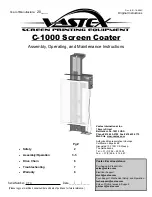
Electrical energy can perform many useful functions.
This projector has been engineered and manufactured to meet
applicable safety standards. IMPROPER USE CAN RESULT IN
POTENTIAL ELECTRICAL SHOCK OR FIRE HAZARDS. In order
not to defeat the safeguards incorporated into this projector,
observe the following basic rules for its installation, use and
servicing.
1.
Unplug the projector from the wall outlet before cleaning or
lamp replacement.
2.
Do not use liquid cleaners or aerosol cleaners. Use a soft dry
cloth to clean the projector unit. If the unit is very dirty, wet a
cloth with neutral detergent, squeeze it tight, wipe the unit
with it, and finish by wiping with a dry cloth.
Do not use a chemical duster or polisher-cleaner because it
can adversely affect the unit and peel the paint.
3.
Do not use attachments not recommended by PHILIPS, as
they may cause hazards.
4.
Do not use the projector near water- for example, near a
bathtub, washbowl, kitchen sink, or laundry tub, in a wet
basement, near a swimming pool, etc. Never spill liquid into
the projector.
5.
Do not place the projector on an unstable cart, stand, or
table. The projector may fall, which may cause serious injury
to a child or an adult and/or serious damage to the unit. Use
only with a cart or stand recommended by its manufacturer
as being suitable for use with a projector.
6.
Ceiling, wall or shelf mounting should be done with a
mounting kit approved by the manufacturer for use with a
projector and should follow the manufacturer’s instructions.
7.
Projector equipment and cart combinations should be moved
with care. Quick stops, excessive force, and uneven surfaces
may cause the equipment and cart combination to overturn.
8.
Slots and openings of the cabinet are provided for ventilation.
To ensure reliable operation of the projector and to protect it
from overheating, these openings must not be blocked or
covered. These openings should never be covered with cloth
or other material. The bottom opening should not be blocked
by placing the projector on a bed, sofa, rug, or other similar
surface. The projector should not be placed near or over a
radiator or heating vent. The projector should not be placed in
a built-in installation such as a bookcase unless proper
ventilation is provided.
9.
The projector should be operated only from the type of
power source indicated on the side of the projector or in the
specifications and with the appropriate mains lead. If you are
not sure of the type of power supplied to your business or
the right type of mains lead, consult your projector dealer or
local power company.
10.
Do not allow anything to rest on the power cord. Do not
place the projector where the cord will be walked on.
11.
Follow all warnings and instructions marked on the projector.
12.
As a safety feature, this projector is equipped with mains
lead with a 3-pin grounded plug (for USA-versions only) or a
2-pin grounded plug (for European versions only). The 3-pin/2-
pin grounded plug will fit only into a grounding type power
outlet. If the plug does not fit, use an adapter that is properly
grounded or have an electrician install a grounded type
outlet. Do not attempt to modify this AC plug.
13.
For added protection of the projector during a lightning
storm, or when it is left unattended or not in use for long
periods of time, unplug it from the wall outlet and disconnect
any cable systems. This will prevent damage to the projector
due to lightning and power-line surges.
14.
Do not overload wall outlets and extension cords with too
many products, because this can cause a fire or electric
shock.
15.
Never push objects of any kind into the projector through
cabinet slots as they may touch dangerous voltage points or
short cut parts, which could result in a fire or electric shock.
16.
Do not attempt to service the projector yourself other than
maintenance issues presented in chapter ‘Maintenance’.
Opening or removing covers may expose you to dangerous
voltage or other hazards. Refer all servicing to qualified
service personnel.
17.
Unplug the projector from the wall outlet and refer servicing
to qualified service personnel under the following conditions:
A.
When the power cord or plug is damaged or frayed.
B.
If liquid has been spilled into the projector.
C.
If the projector has been exposed to rain or water.
D.
If the projector does not operate normally when you
follow the operating instructions. Adjust only those
controls that are covered by the operating instructions;
improper adjustment of other controls may cause
damage and will often require extensive work by a
qualified technician to restore the projector to normal
operation.
E.
If the projector has been dropped or the cabinet has
been damaged.
F.
When the projector exhibits a distinct change in
performance – (this indicates a need for service).
18.
Upon completion of any service or repairs to the projector,
ask the service technician to perform a routine safety check
to check that the projector is in safe operating condition.
19.
When replacement parts are required, be sure the service
technician has used replacement parts specified by the
manufacturer that have the same characteristics as the
original parts. Unauthorized substitutions may result in fire,
electric shock, or other hazards.
20.
It is recommended to clean the air filter after every 100 lamp
hours. The projector may become too hot if the filter is not
cleaned when required.
21.
If the lens becomes dirty or smudged, clean it with a clean,
dampened cloth. Never touch the lens with your fingers.
22.
Do not look directly into the aperture and lens while
operating the projector as this may damage your eyes.
S
CAUTION: Please read all of these instructions
before you operate your projector.
Save these instructions for future
reference.
3. Important Safeguards
4
XP Hopper SV30 Eng.* 05-09-2000 11:56 Pagina 4






































